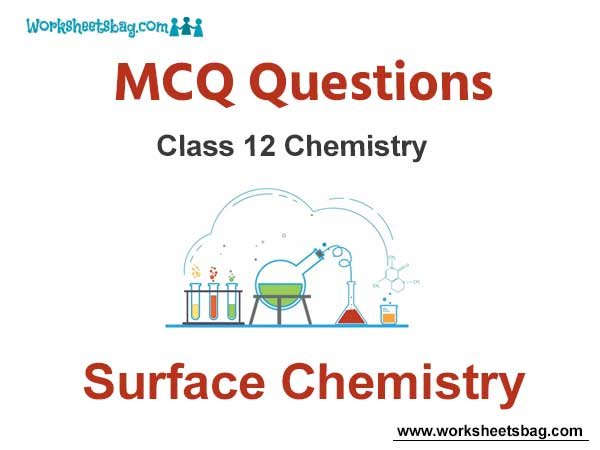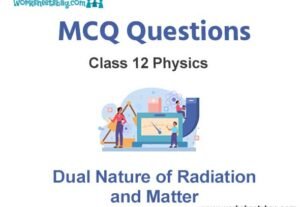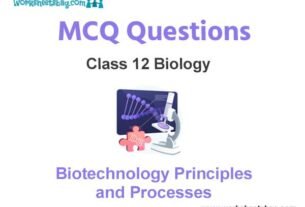Please refer to Surface Chemistry MCQ Questions Class 12 Chemistry below. These MCQ questions for Class 12 Chemistry with answers have been designed as per the latest NCERT, CBSE books and syllabus issued for the current academic year. These objective questions for Surface Chemistry will help you to prepare for the exams and get more marks.
Surface Chemistry MCQ Questions Class 12 Chemistry
Please see solved MCQ Questions for Surface Chemistry in Class 12 Chemistry. All questions and answers have been prepared by expert faculty of standard 12 based on latest examination guidelines.
Question. Which of the following electrolytes is least effective in coagulating ferric hydroxide solution?
(a) KBr
(b) K2SO4
(c) K2CrO4
(d) K4[Fe(CN)6]
Answer
A
Question. The concentration of electrolyte required to coagulate a given amount of As2S3 sol is minimum in the case of
(a) magnesium nitrate
(b) potassium nitrate
(c) potassium sulphate
(d) aluminium nitrate
Answer
D
Question. Which is the wrong pair?
I. Starch solution : sol
II. Aq. NaCl : true solution
III. milk : emulsion
IV. Aq. BaSO4 : true solution
(a) Only I
(c) Only IV
(b) Only III
(d) Only II
Answer
C
Question. Pick out the statement which is not relevant in the discussion of colloids.
(a) Sodium aluminium silicate is used in the softening of hard water
(b) Potash alum is used in shaving rounds and as a styptic in medicine
(c) Artificial rain is caused by throwing electrified sand on the clouds from an aeroplane
(d) Deltas are formed at a place where the river pours its water into the sea
Answer
A
Question. Which one of the following does not involve coagulation ?
(a) Formation of delta regions
(b) Peptization
(c) Treatment of drinking water by potash alum
(d) Clotting of blood by the use of ferric chloride
Answer
B
Question. Four different colloids have the following gold number, which one has most effective action?
(a) 5
(b) 10
(c) 15
(d) 13
Answer
A
Question. Fog is a colloidal solution of
(a) solid in gas
(b) liquid in gas
(c) gas in liqttid
(d) gas in solid
Answer
B
Question. Select wrong statement.
(a) If a very small amount of AICI3 is added to gold sol, coagulation occurs, but if a large quantity of AICI3 is added, there is no coagulation.
(b) Organic ions are more strongly adsorbed on charged surfaces in comparison to inorganic ions.
(c) Both emulsifier and peptising agents stabilised colloids but their actions are different.
(d) Colloidal solutions are thermodynamically stable.
Answer
A
Question. The colloidal solution is purified by the following process
(a) disintegration
(b) peptisation
(c) filtration
(d) dialysis
Answer
D
Question. Gold numbers of protective colloids A, B, C and D are 0.50, 0.01, 0.10 and 0.005, respectively. The correct order of their protective powers is
(a) D < A < C < B
(b) C < B < D < A
(c) A < C < B < D
(d) B < D < A < C
Answer
C
Question. An emulsion is a colloidal dispersion of
(a) a liquid in a gas
(b) a liqttid in a liquid
(c) a solid in a liquid
(d) a gas in a solid
Answer
B
Question. Negatively charged colloidal solution of clay in water will need for precipitation the minimum amount of
(a) aluminium sulphate
(b) potassium sulphate
(c) sodium hydroxide
(d) hydrochloric acid
Answer
A
Question. Which is more powerful to coagulate the negative colloid?
(a) ZnSO4
(b) Na3PO4
(c) AICI3
(d) K4 [Fe(CN)6 ]
Answer
C
Question. All colloidal dispersions have
(a) low osmotic pressure
(b) no osmotic pressure
(c) high osmotic pressure
(d) very high osmotic pressure
Answer
A
Question. An example of dispersion of a liquid in a gas is
(a) milk
(b) vegetable oil
(c) foam
(d) mist
Answer
D
Question. Milk is a kind of
(a) sol
(b) gel
(c) emulsion
(d) mixture
Answer
C
Question. Which has least gold number ?
(a) Gelatin
(b) Starch
(c) Albumin
(d) Blood
Answer
A
Question. The colour of sky is due to
(a) transmission of light
(b) wavelength of scattered light
(c) absorption of light by atmospheric gases
(d) All of the above
Answer
B
Question. Associated colloid among the following is
(a) enzymes
(b) proteins
(c) cellulose
(d) starch
(e) sodium stearate
Answer
E
Question. The size of colloidal particles is in between
(a) 10-7 – 10-9 cm
(b) 10-9 – 10911 cm
(c) 10-5– 10-7 cm
(d) 10-2 – 10-3 cm
Answer
C
Question. Which of the following will be the most effective in the coagulation ofFe(OH)3 sol?
(a) Mg3 (PO4 )2
(b) BaCI2
(c) NaCl
(d) KCN
Answer
A
Question. Among the electrolytes Na2SO4 , CaCl2 , Al2 (SO4 )3 and NH4Cl, the most effective coagulating agent for Sb2S3 sol lS
(a) Na2SO4
(c) Al2 (SO4 )3
(b) CaCl2
(d) NH4Cl
Answer
C
Question. Which of the following has maximum coagulation power with ferric hydroxide sol ?
(a) Cryolite
(b) K2C2O4
(c) K3[Fe(CN)]6
(d) K4 [Fe(CN)6]
Answer
D
Question. The ion that is more effective for the coagulation of As2S3 sol is
(a) Ba 2+
(b) Na+
(c) PO3-4
(d) SO2-4
(e) Al3-
Answer
E
Question. Which one of the following is a lyophilic colloidal solution ?
(a) Smoke
(b) Gold sol
(c) Starch aqueous solution
(d) Cloud
Answer
C
Question. Which of the following electrolyte will have maximum flocculation value for Fe(OH)3 sol?
(a) NaCl
(b) Na2S
(c) (NH4)3PO4
(d) K2SO4
Answer
A
Question. The basic principle ofCottrell’s precipitator is
(a) Le-Chatelier’s principle
(b) peptisation
(c) neutralisation of charge on colloidal particles
(d) scattering of light
Answer
C
Question. From the following which is not an emulsifier?
(a) Agar
(b) Milk
(c) Gum
(d) Soap
Answer
B
Question. Blue colour of water in sea is due to
(a) refraction of blue light by impurities
(b) refraction of blue sky by water
(c) scattering of light by water
(d) None of the above
Answer
C
Question. The number of moles of lead nitrate needed to coagulate 2 moles of colloidal [ Agl]I– is
(a) 2
(b) 1
(c) 1/ 2
(d) 2/3
(e) 5/2
Answer
B
Question. Mention the type of reaction to obtain Au (sol).
Reaction, 2AuCI3 + 3HCHO+ 3H2O → 2Au(sol)
+ 3HCOOH + 6HCI
(a) Hydrolysis
(b) Oxidation
(c) Reduction
(d) Double decomposition
Answer
C
Question. Which of the following is not a property of colloidal solution?
(a) Heterogeneity
(b) Particle size > 100 nm
(c) Tyndall effect
(d) Brownian movement
Answer
B
Question. The phenomenon observed when a beam of light is passed through a colloidal solution is
(a) cataphoresis
(b) dielectrophoresis
(c) coagulation
(d) Tyndall effect
Answer
D
Question. Among the following, the surfactant that will form micelles in aqueous solution at the lowest molar concentration at ambient conditions, is
(a) CH3(CH2 )15 N+ (CH3 )3 Br–
(b) CH3(CH2 )11 OSO–3 N+
(c) CH3(CH2 )6 COO– N+
(d) CH3(CH2 )11N+ (CH3 )3 Br–
Answer
A
Question. Sulphw· colloid is prepared by
(a) mechanical dispersion
(b) oxidation
(c) electrical dispersion
(d) reduction
Answer
B
Question. Which of the following is not a method of preparation of colloidal solution ?
(a) Electrical dispersion
(b) Peptization
(c) Coagulation
(d) Mechanical dispersion
Answer
C
Question. Colour of colloids depend on which of the factors?
(a) Size
(b) Mass
(c) Charge
(d) Nature
Answer
A
Question. Tyndall effect would be observed in
(a) solvent
(b) solution
(c) colloidal solution
(d) precipitate
Answer
C
Question. The formation of colloid from suspension is
(a) peptisation
(b) condensation
(c) sedimentation
(d) fragmentation
Answer
A
Question. Size of colloidal particles is in the range
(a) 0.05 mμ – 0.1 mμ
(b) 25 μ- 30 μ
(c) 0.1μ – 1 mμ
(d) 10 μ – 20 μ
Answer
C
Question. An emulsifier is a substance which
(a) stabilises the emulsion
(b) homogenises the emulsion
(c) coagulates the emulsion
(d) accelerates the dispersion of liquid in liquid
Answer
A
Question. When a sulphur sol is evaporated sulphur is obtained. On mixing with water sulphur sol is not formed. The sol is
(a) lyophilic
(b) reversible
(c) hydrophobic
(d) hydrophilic
Answer
C
Question. Which of the following has maximum value offlocculating power ?
(a) Pb2+
(b) Pb4+
(c) Sr2+
(d) Na+
Answer
B
Question. Lyophilic sols are
(a) irreversible sols
(b) they are prepared from inorganic compounds
(c) coagulated by adding electrolytes
(d) self-stabilising
Answer
D
Question. Bleeding due to a cut can be stopped by applying ferric chloride solution in the laboratory.
This is due to
(a) coagulation ofnegatively charged blood pa1ticles by Fe3- ions
(b) coagulation of positive( y charged blood particles by CI– ions
(c) reaction taking place between ferric ions and the haemoglobin forming a complex
(d) common element, iron, in both FeCl3 and haemoglobin
Answer
A
Question. On adding 1 mL of solution of 10% NaCl to 10mL of gold sol in the presence of 0.25 g of starch, the coagulation is just prevented. The gold number of starch is
(a) 0.25
(b) 0.025
(c) 2.5
(d) 25
(e) 250
Answer
E
Question. The gold numbers of some colloidal solutions are given below.

The protective nature of these colloidal solutions follow the order
(a) C > B > A
(b) A > B > C
(c) A = B = C
(d) B > A > C
Answer
B
Question. The continuous phase throughout, example is contains the dispersed phase
(a) water in milk
(b) fat in milk
(c) water droplets in mist
(d) oil in water
Answer
C
Question. When dilute aqueous solution of AgNO3 (excess) is added to KI solution, positively charged sol of Ag! is formed due to adsorption of
(a) NO–3
(b) O2
(c) Ag+
(d) K+
Answer
C
Question. Tyndall effect shown by colloids is due to
(a) scattering of light by the particles
(b) movement of particles
(c) reflection of light by the particles
(d) coagulation of particles
Answer
A
Question. Peptisation denotes
(a) digestion of food
(b) hydrolysis of proteins
(c) breaking and dispersion into colloidal state
(d) precipitation of solid from colloidal dispersion
Answer
C
Question. Gold number is associated with
(a) electrophoresis
(b) protective colloids
(c) Tyndall effect
(d) isotonic solutions
Answer
B
Question. The volume of a colloidal particle, VC as compared to the volume of a solute particle in a true solution Vs, could be
(a) VC / Vs ≈ 103
(b) VC / Vs ≈ 10-3
(c) VC / Vs ≈ 1023
(d) VC / Vs ≈ 1
Answer
A
Question. The disperse phase in colloidal iron (III) hydroxide and colloidal gold is positively and negatively charged, respectively. Which of the following statements is not correct ?
(a) Coagulation in both sols can be brought about by electrophoresis
(b) Mixing the sols has no effect
(c) Sodium sulphate solution causes coagulation in both sols
(d) Magnesium chloride solution coagulates the gold sol more readily than the iron (III) hydroxide sol
Answer
B
Question. The disperse phase, dispersion medium and nature of colloidal solution (lyophilic or lyophobic) of ‘gold sol’ respectively are
(a) solid, solid, lyophobic
(b) liquid, liquid, lyophobic
(c) solid, liquid, lyophobic
(d) solid, liquid, lyophilic
Answer
C
Question. If liquid is dispersed in solid medium, this is called
(a) sol
(b) emulsion
(c) liquid aerosol
(d) gel
Answer
D
Question. The colloidal system of a solid dispersed in liquid medium, is called
(a) aerosol
(b) sol
(c) gel
(d) foam
Answer
B
Question. Lyophilic sols are more stable than lyophobic sols because the particles
(a) are positively charged
(b) are negatively charged
(c) are solvated
(d) repel each other
(e) are heavy
Answer
C
Question. Which of the following is not correct ?
(a) Milk is a naturally occurring emulsion
(b) Gold sol is a lyophilic sol
(c) Physical adsorption decreases with rise in temperature
(d) Chemical adsorption is unilayere
Answer
B
Question. Alloy is an example of
(a) gel
(b) solidified emulsion
(c) solid solution
(d) sol
Answer
C
Question. In colloid particles, range of diameter is
(a) 1 to 100 nm
(b) 1 to 1000 cm
(c) 1 to 1000 mm
(d) 1 to 100 km
Answer
A
Question. Which one of the following impurities present in colloidal solution cannot be remove by electrodialysis?
(a) Sodium chloride
(b) Potassium sulphate
(c) Urea
(d) Calcium chloride
(e) Magnesium chloride
Answer
C



